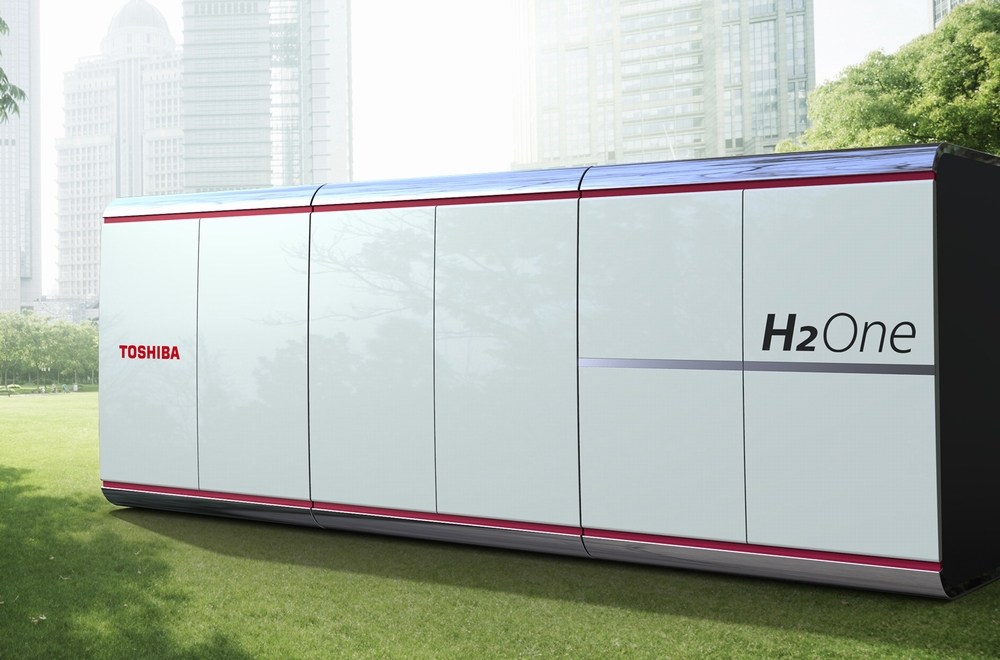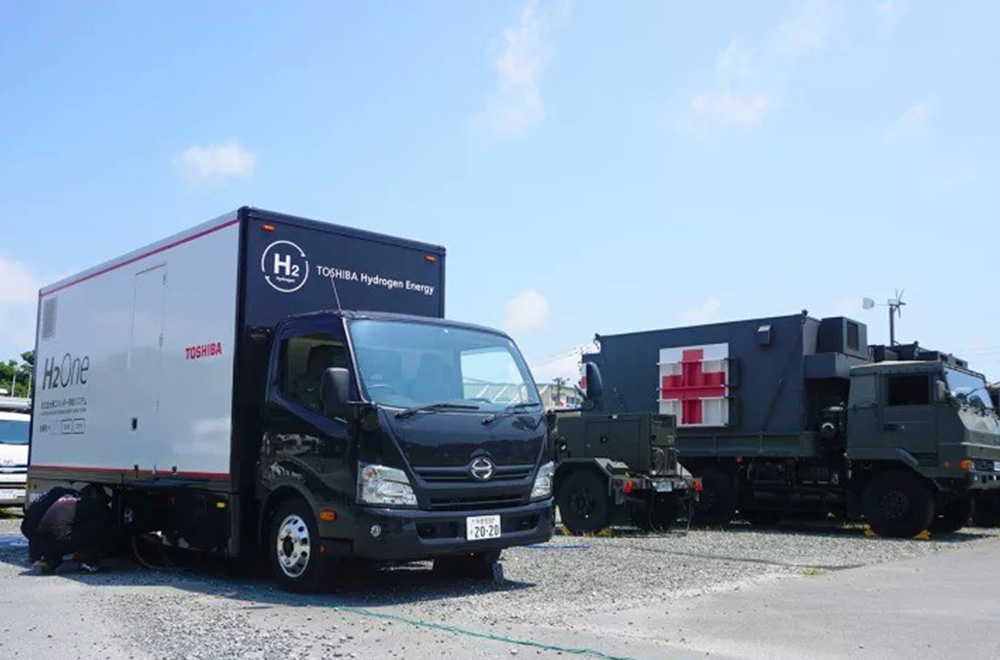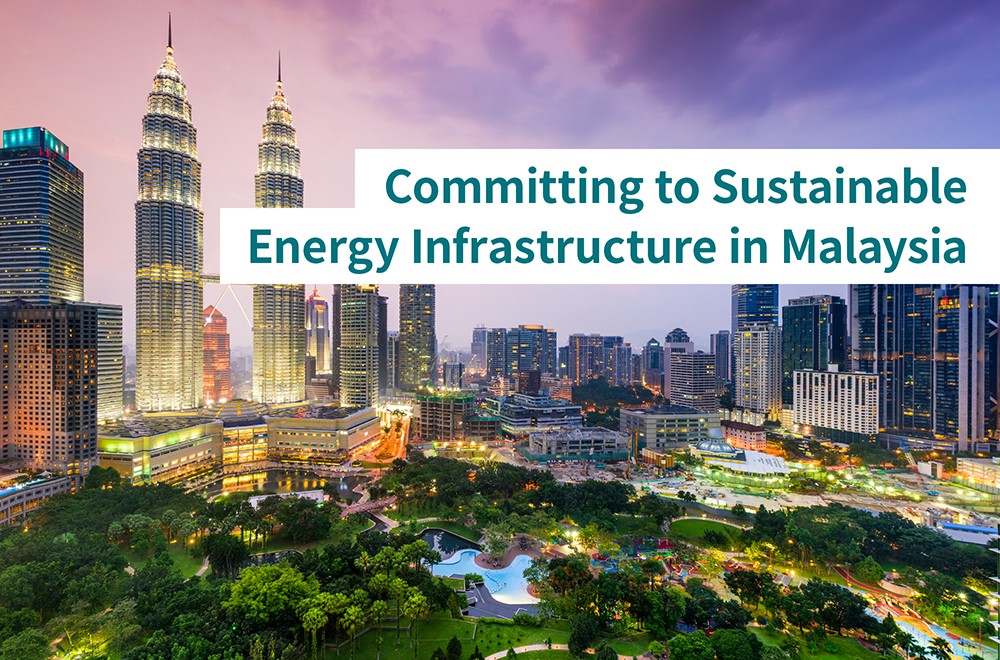A Beacon of Light, a Dream Come True in Fukushima: The Front Lines of Hydrogen Energy
2020/09/23 Toshiba Clip Team
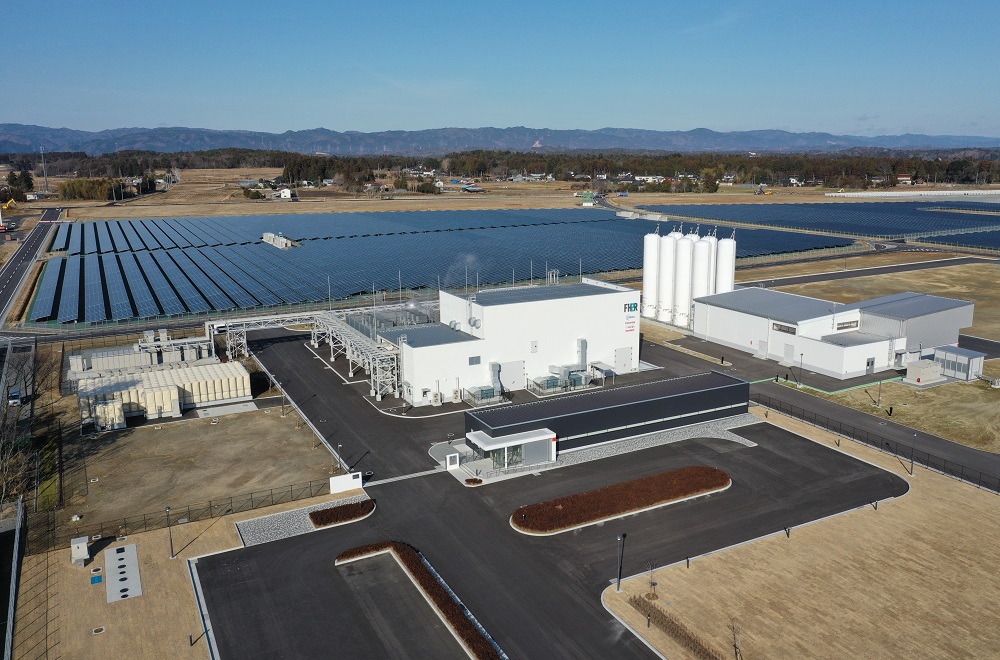
Hydrogen energy may seem like a dream, but it’s the future. A new form of energy that’s environmentally friendly and available in steady supplies, it’s now being developed and implemented throughout the world. In Japan, the realization of what’s called a “hydrogen society”—a society powered by a clean, inexhaustible hydrogen energy supply—has become a national goal. In the future, hydrogen energy will be the foundation that supports a variety of infrastructure, from fuel cell cogeneration to modes of transportation, including fuel-cell cars and buses.
The Japan government’s “Basic Hydrogen Strategy” outlines an action plan towards 2030, and a vision towards 2050. A critical component of this strategy is the Fukushima Hydrogen Energy Research Field (hereafter “FH2R”).
The aim of the FH2R project is to demonstrate the feasibility of hydrogen as an energy resource by July 2020. The project, located in Japan’s Namie town, Fukushima Prefecture, with a vast field of approximately 220,000㎡, is equipped with a 10 megawatt (MW) hydrogen production unit—the largest-class in the world—and a 20MW solar power generation unit. The New Energy and Industrial Technology Development Organization (NEDO) assigned Toshiba Energy Systems & Solutions Corporation with the overall management of the project, with Tohoku Electric Power Co., Inc., and Iwatani Corporation responsible for the construction work, which started in July 2018.
To understand more about FH2R and its applications to realize the vision for a hydrogen society, we speak to those involved in this project.
A clean, inexhaustible source of energy: Is hydrogen as an energy source considered as a dream come true?
“Are hydrogen cars the vehicles of the future?” In recent years, these headlines have surfaced in the news as more hydrogen vehicles and hydrogen fueling stations are springing up in some countries. Hydrogen energy is gaining heightened awareness and a widespread use of this energy is expected.
There are several reasons for this increasing adoption of hydrogen energy. Hydrogen doesn’t produce CO2 emissions in the process of being converted to electricity, and has a lot of potential to alleviate environmental issues, including global warming. There is an inexhaustible supply of hydrogen on the planet, and a variety of different methods to generate it. It can also be stored and transported over long distances, which is why countries like Japan is looking to hydrogen energy as a way to reduce its dependence on foreign countries for energy sources, such as fossil fuels. Hydrogen energy, it seems, is looking more and more like the energy of the future.
In the FH2R system, hydrogen is produced in a hydrogen production unit that uses electricity derived from a combination of renewable energy generated in the solar power generation unit and the grid. The hydrogen is subsequently stored for use in various applications. The entire process, from production to actual usage, is CO2-free. The goal is to establish an environmentally friendly hydrogen supply system.
Toshiba Energy Systems & Solutions Corporation undertakes the overall responsibility of the management of the project, as well as the overall hydrogen energy system. Tohoku Electric Power Co., Inc. manages the control system of the power grid, and Iwatani Corporation handles the storage, supply of hydrogen, and the hydrogen demand and supply forecasting system. We spoke to Fumiyuki Yamane, Hydrogen Energy Business Division, Toshiba Energy Systems & Solutions Corporation who has been involved in the project since the open call by NEDO.
“The FH2R system manages the production and storage of hydrogen according to the demand forecasts made by the hydrogen demand and supply forecasting system, and adjusts the amount of hydrogen produced by the hydrogen production unit to keep demand and supply balanced in the power grid. The system also employs efficient use of the electricity that comes from the renewable energy generated in the solar power generation unit. Indeed, the heart of this project is the system control technology, which manages three factors—hydrogen production and storage, supply-demand adjustments in the power grid, and the use of electricity derived from renewable energy—in the most optimal way.”
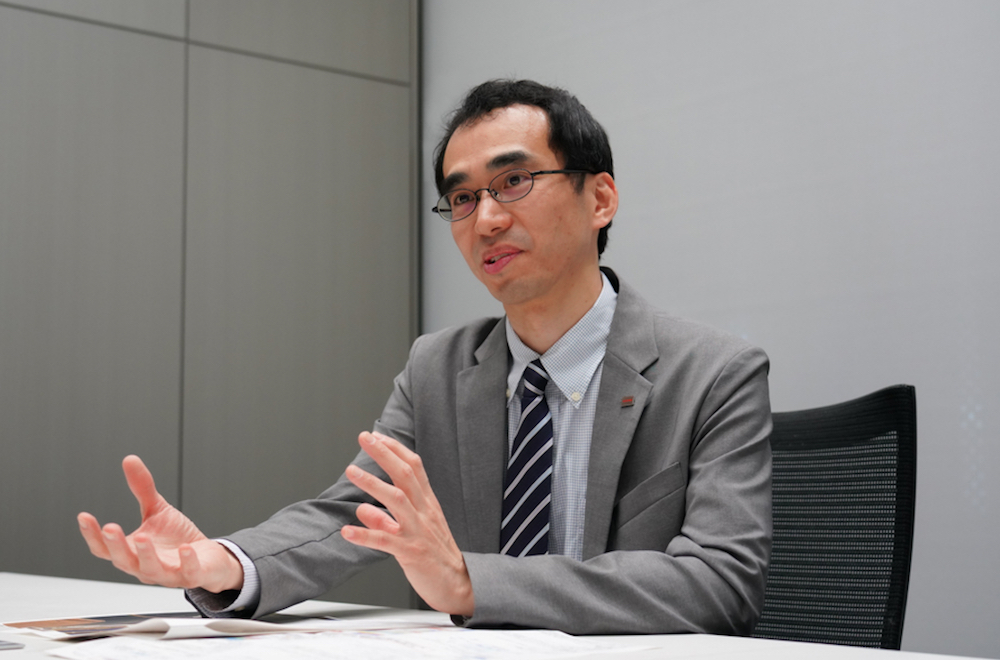
Fumiyuki Yamane, Manager, Power To Gas Business Development Group, Business Development Dept., Hydrogen Energy Business Div., Toshiba Energy Systems & Solutions Corporation
The demand for renewable energy is on the rise in Japan. However, systems such as solar power generation and wind power generation are dependent on weather conditions and can cause major fluctuations in power output. These fluctuations pose challenges to maintain the balance of supply and demand of power. FH2R, a large-scale system mitigates the risks of these fluctuations by making supply-demand adjustments in the system and utilizing renewable energy to produce hydrogen and stores/transports the hydrogen for various uses.
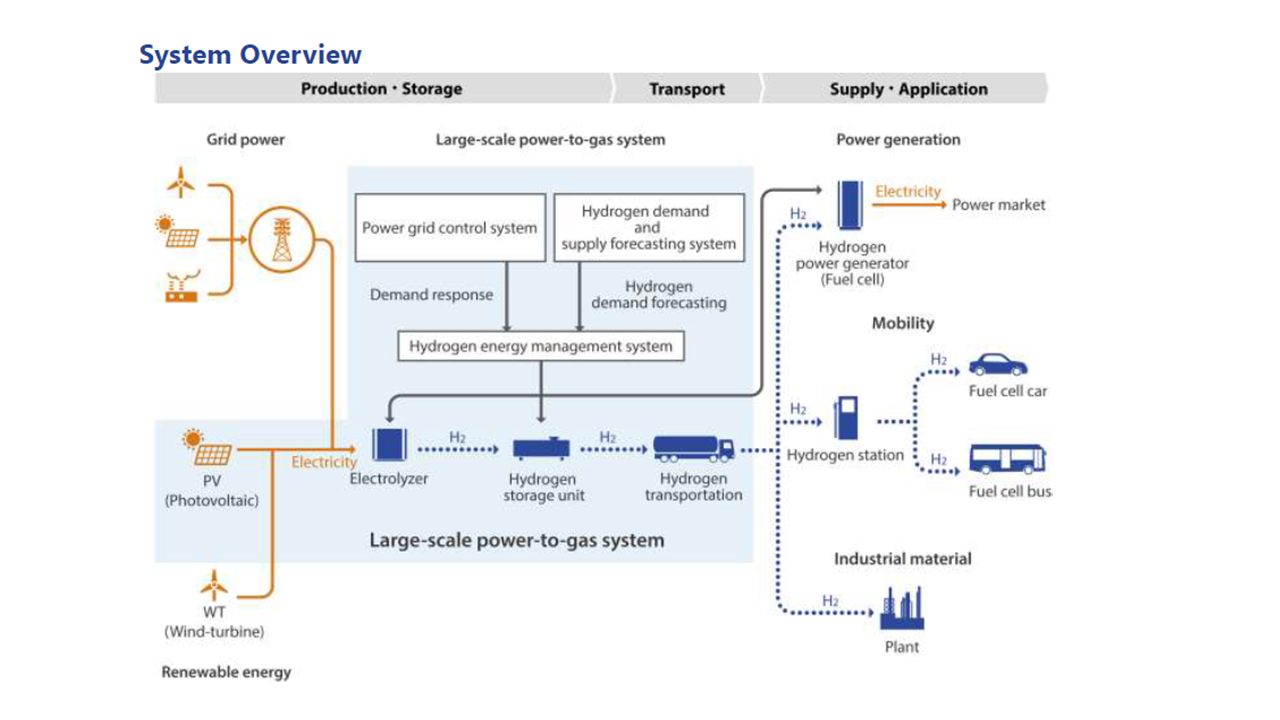
“FH2R is what’s called a Power-to-Gas (other terms used: power to gas, P2G, PtG) system. A number of countries in Europe, for example Germany, have been ahead in the power-to-gas field. These countries realize that they are unable to reduce CO2 emissions sufficiently and achieve their targets through the electricity sector alone, that they need to implement other measures simultaneously, including targeting the transportation and industrial sectors. As they look for the best ways to do so, they recognize that power-to-gas, which utilizes electrolysis to convert electricity, derived from renewable energy, to hydrogen, is a possible key to their strategies. In Japan, there is also a need to refine the foundational technologies for power-to-gas systems, if we’re to reduce CO2 emissions and expand the use of renewable energy. We want to be able to compete on the same playing field as countries in Europe. So there’s been a lot of anticipation surrounding the FH2R project, especially with this system being the first of its kind in the world,” said Yamane.
FH2R has started operations as the world’s first largest-scale power-to-gas system. The facility opened in March 2020, and hydrogen production and transport commenced in July, as part of the feasibility demonstration. The hydrogen produced is expected to be utilized in applications including fuel cell power generation, fuel-cell cars, and fuel in factories.
An environmentally-friendly energy management system that predicts hydrogen demand and balances electricity demand and supply
Toshiba Corporation is involved in the energy infrastructure field since its inception, and has vast experience in the applications of hydrogen. Toshiba’s long-cultivated technological foundation and expertise contributed to the successful appointment of Toshiba Energy Systems & Solutions Corporation as the lead engineering, procurement and construction (EPC) provider for this FH2R project.
“We came up with a concept that addressed both the supply-demand balance in the power grid, and the demand for hydrogen. We also demonstrated how important this would be applied in large-scale power-to-gas systems for widespread use in the future. This concept involved a variety of methods, including an environmental analysis of energy usage and analyses of the operating model. In terms of system requirements, it was important that the Iwatani Corporation’s system could calculate and generate information on how much hydrogen would be needed, and that the Tohoku Electric Power’s system could calculate and offer information on the supply-demand balance in the power grid. We also showed how important it was to have a management system that could utilize this information and meet the demands of both sides. I believe we were evaluated well based on these results,” said Yamane.
The Toshiba Group has been involved in the design and operation of many forms of large-scale infrastructure, including thermal and hydroelectric power plants, and the Group’s expertise proved invaluable to this project―a large-scale hydrogen power plant that is the first of its kind in the world.
“FH2R is significant to Toshiba as it is the largest hydrogen project undertaken so far for the company. This is also the company’s first assignment to manage the entire hydrogen energy system, from ground preparations to installation of this large-scale system. We are working with many organizations including Tohoku Electric Power Co., Inc. and Iwatani Corporation, along with other suppliers like Kajima Corporation, and coordinating closely with NEDO, Japan’s Agency for Natural Resources and Energy and government agencies handling the administration of Fukushima Prefecture and Namie Town.” said Yamane.
The company also believes in embracing diversity in the workplace and giving fair opportunities to all employees. Keita Nakajima joined Toshiba in 2019 and he is assigned to support the construction process and be a point of contact with partner companies. “It’s great to see Nakajima handling the on-site communications, and keeping contact with all of the different agencies with such enthusiasm,” said Yamane. For younger employees like Nakajima, being able to gain so much on-site knowledge and expertise in the hydrogen business—a business that will continue well into the future—is a valuable experience.
“It’s been so amazing to be a part of such a large-scale project as a new joiner. In graduate school, I did some research on the storage and transportation of hydrogen. But really, I wanted to move away from the desk research, and work on commercial applications. This is my motivation in working with partner companies, and managing the progress of the project,” said Nakajima.

Keita Nakajima, Power To Gas Business Development Group, Business Development Dept., Hydrogen Energy Business Div., Toshiba Energy Systems & Solutions Corporation
Aiding restoration and being a guiding light towards a brighter, hydrogen-fueled future
With the project members and partner companies making steady progress, the world’s largest-scale hydrogen energy system is now becoming a reality on the fields of Fukushima Prefecture. Yamane, who oversees the facility as Project Manager, shares the mindsets that he considers important in the day-to-day work. “Co-creation, with everyone. Doing the right thing, even when a situation seems unreasonable. Ensuring we keep our promises, and to achieve what we’ve promised. Maintaining an environment where everyone involved remains driven and motivated to make this project a success. Getting things done, making smart decisions, and staying motivated, more so than any other person involved.” He went on to say,
“We were told this would be a very challenging project. However, as all members of the project understood the significance and the contributions this project would bring, we persevered to overcome difficult situations and completed important phases of the project on schedule. Our achievements rested on the respect and trust with the people around us and the common goal as our source of motivation.”
Nakajima, passionate about the societal applications of hydrogen energy, envisions a bright, hydrogen-fueled future. Having given earnest thought to the value and meaning that hydrogen energy could offer the world, he is now working as hard as he can towards its widespread application.
“The reality is that many people still don’t know how clean and safe an energy source hydrogen is. FH2R is an experimental facility that’s working towards a hydrogen society for 2030 and beyond. The goal of this project is to use widely available energy resources, and making hydrogen energy to be a common source of energy in the next generation. That’s the goal, but first we need to strengthen the foundation for this application in Fukushima,” said Nakajima.
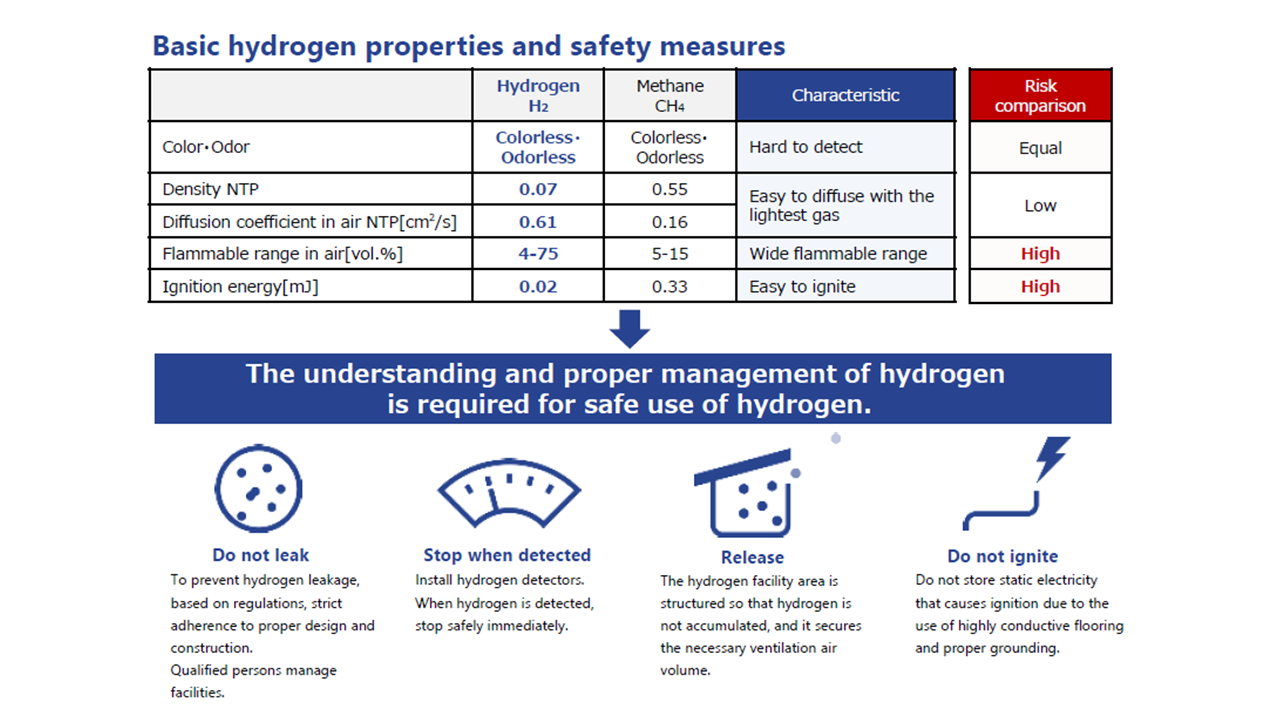
FH2R delivers next-generation energy from Fukushima, an area devastated by the Great East Japan Earthquake. In the opening ceremony for FH2R in March 2020, Prime Minister of Japan, Shinzo Abe shared the importance of the FH2R facility for the realization of a hydrogen society. “Fukushima Prefecture, a region severely affected by the nuclear power station accidents, is now about to turn a new page toward a hydrogen society in the future. Hydrogen-fueled vehicles and buses will run across Tokyo and hydrogen-based electricity will be used. In the year of 2020 and toward the future beyond 2020, Japan will strive to achieve a hydrogen society in a single burst. To this end, I believe that FH2R will work as the world’s largest-class innovation base.” The hydrogen produced at FH2R is also to signify the “official” recovery of the Fukushima area.
“Our work is an important part of the recovery process for Fukushima and this has been a major source of motivation for us. Our efforts will also help make hydrogen more widely known, and be recognized as an energy infrastructure in the same vein as, for example, thermal power generation. This is the expectation for the near future, and FH2R is the flagship technology that will help us realize this vision.
By conducting feasibility demonstrations of the control system we’ve been refining, we’ll be able to gain further expertise, and realize a power-to-gas system with an even more advanced management system in the future,” said Yamane.
In many ways, hydrogen energy may be the guiding light to illuminate a better future. And with FH2R, we take the first step—towards a healthful recovery from the Great East Japan Earthquake, and the hydrogen society we are all working towards.
![]()
Related Links
*This section contains links to websites operated by companies and organizations other than Toshiba Corporation.
https://www.toshiba-energy.com/en/hydrogen/index.htm





